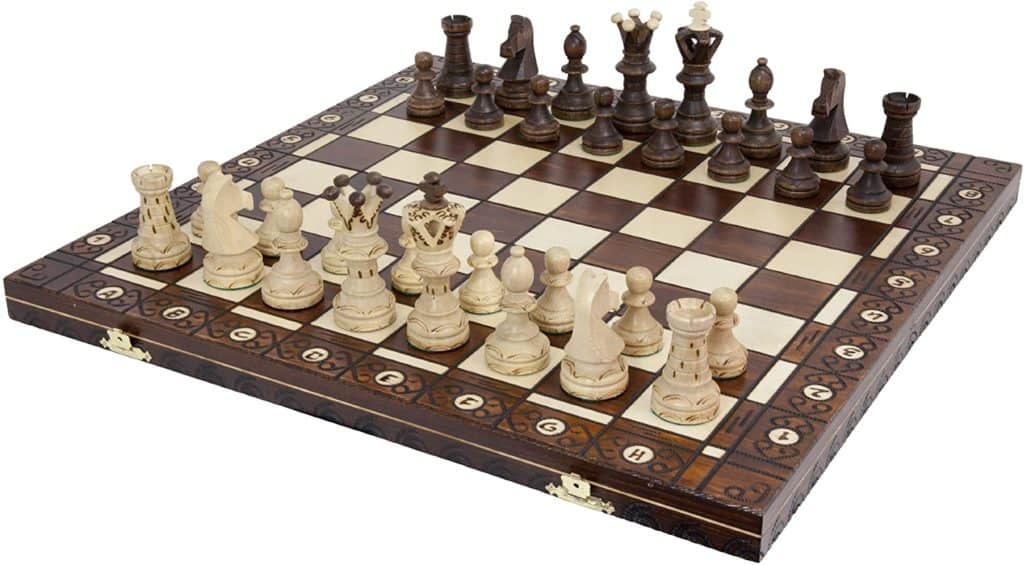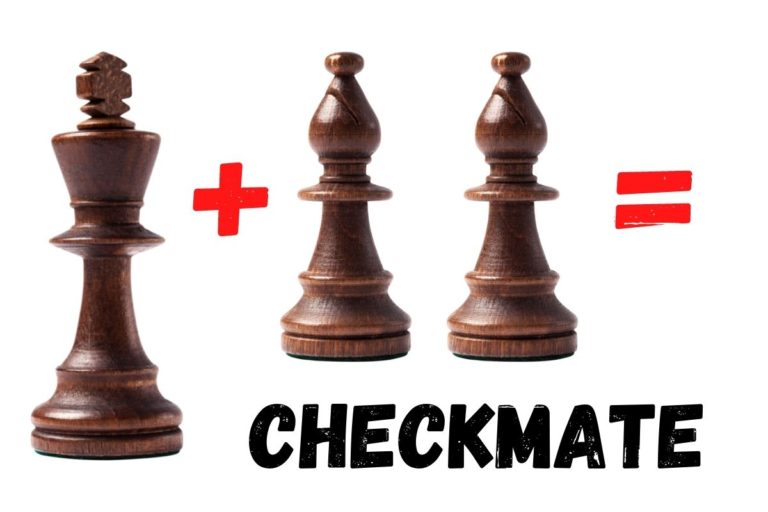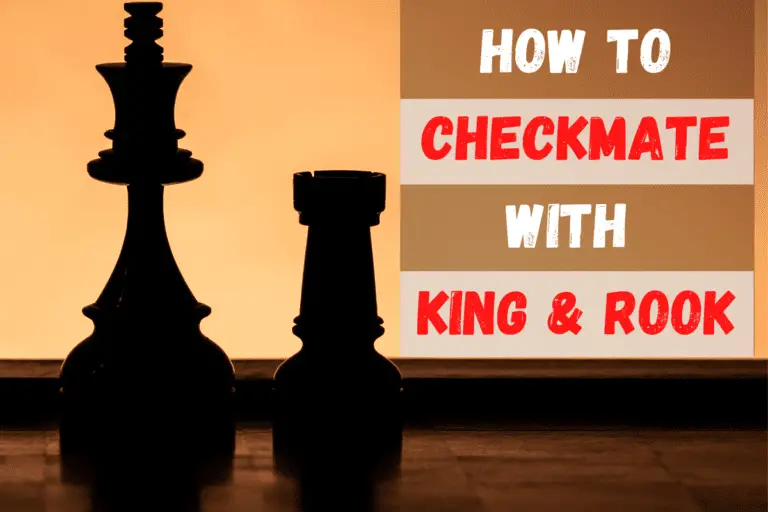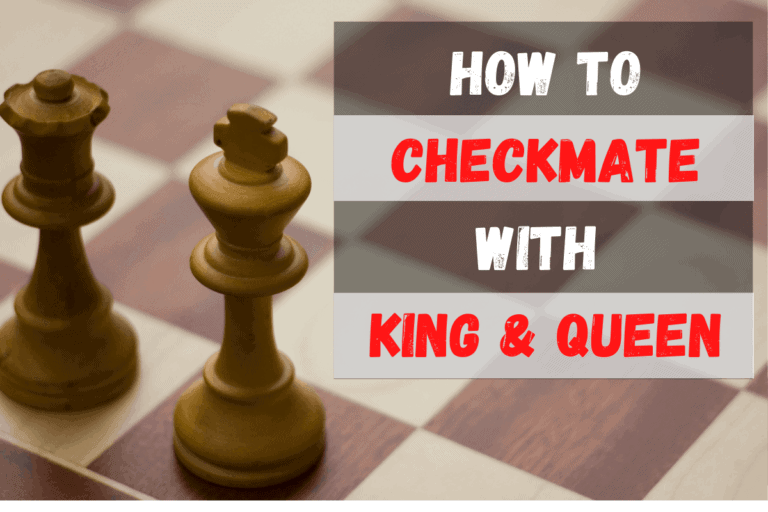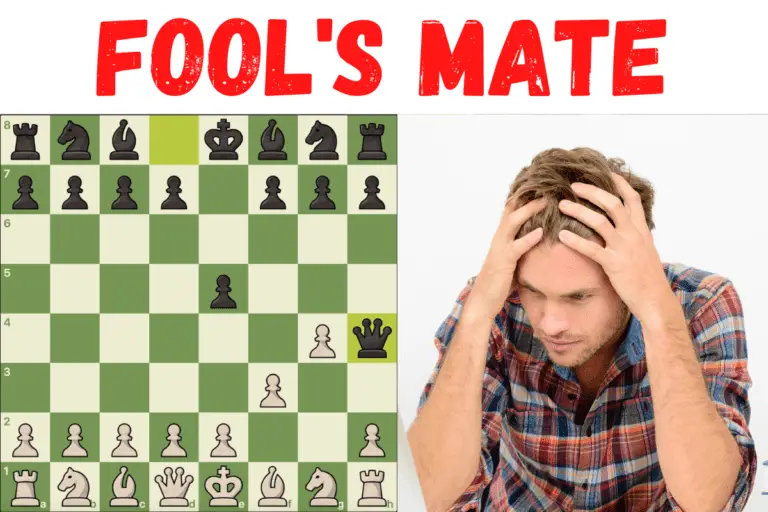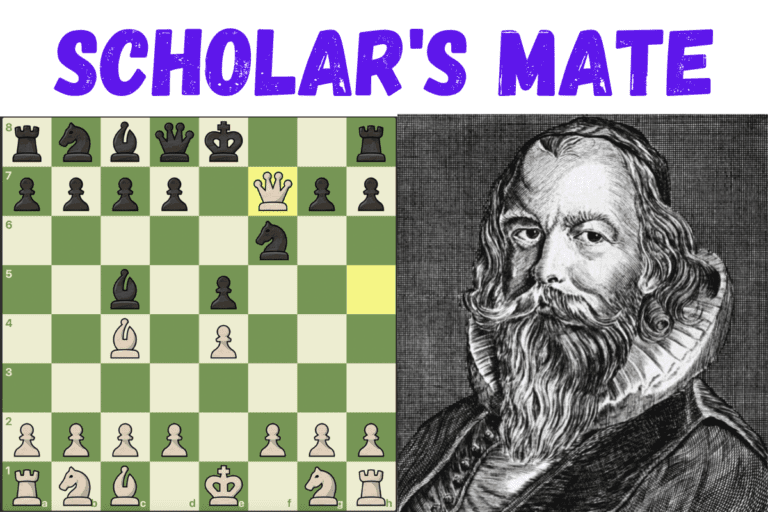Smothered Mate in Chess (3 Moves – vs Caro-Kann & How to Avoid)
⭐⭐⭐ Take 7 minutes to read and improve your chess game ➡️ : This article was first published on, and is Copyright of Chessquestions.com
One of the 101 rules of chess in terms of defense is making sure your King has a possible escape route on the chess board for when it is under attack from any type of mate situation. Failure to allow for this and to have every square around the king occupied leaves a player prone to the Smothered mate in chess.
A smothered mate occurs when a king is entirely surrounded on adjacent squares by its own pieces and the opponent has moved their knight to a check position on an undefended square. The checking knight can not be captured and because the King is surrounded it is unable to escape. Checkmate, the game is over.
It is possible to manage a three-move checkmate with a smothered mate making it one of the quickest possible checkmates in chess. Just three moves with the Knight are required, believe it or not, to achieve it.
It is rare to see the smothered mate this quickly. It is far more common to occur when the King has Castled and moved to the corner of the chessboard.
3-Move Smothered Checkmate
As one of the fastest possible checkmates in chess, the Smothered Mate is also the fastest to utilize just one piece and three moves to achieve victory. It is an idea to learn those moves just in case you ever fancy playing it against a lower-rated opponent who may not see it coming.
Imagine using only one piece from the start of the game and defeating your opponent by moving it just three times. How embarrassing for them, but it is perfectly possible and relies not only on you making the right move but also on your opponent making one critical blunder in front of their own King.
Let’s take a look at the 3-Move Smothered Checkmate
Smothered can be achived mate in just three moves playing this opening for black pieces. The only trouble with this checkmate is that is does require two quite specific mistakes from white within the first three moves, but when playing novice player, this can potentially happen more often than you might think
- White opens with e4 typically, this is the most common opening in chess and begins the 3 move checkmate opportunity.
- Black Knight to c6 – If White opens with e4, the most common opening move in all of chess, then you play your Queens Knight to c6. Remember you will only ever use this Knight if things go right, and will not need to touch any other piece before you defeat your opponent.
- What you really need here is for White to play a pawn two squares forward on g4. Of course, g4 night has been the opening move too. No matter, this move removes any threat on the eventual f3 square you are aiming to reach with your Knight in three moves.
- Now move Black Knight to D4 – This creates a threat on the c6 pawn threatening to fork the King and Rook. It is unlikely you ould make this move as the Knight would be hung for the Queen to take without threat, o what you are hoping for here is white to consider that you will not make that move but to attack your Knight now on d4 with their own King’s side Knight.
- White needs to move their Knight to e2 which threatens your knight on d4. Which indeed it does and can threaten to take your Knight if not moved. But of course, you are going to make the final move of this particular game removing the fork threat and delivering something far more devastating in the form of a smothered mate.
- Move your Knight to f3 – Checkmate! – The knight can not be captured and the white King is surrounded on all sides and is unable to escape.
- You have just achieved the three-move checkmate using just the Knight to gain a smothered mate in a record time.
Other Smothered Mates.
The smothered mate is not only restricted to just that three-move opening brutal blast, it is far more common to occur when a King has been castled, either King or Queenside, and is not toward the corner. Heavy defense is not always a great thing especially if you are attacking with roving Knight with their special move abilities.
Once the King is in the corner, it becomes in a position where it does not have a move to make, it is usually quite easy for the Knights to make their move and trap you in the corner of the board.
Queen Sacrifice Smothered Mate
A famous version of the smothered mate involves the sacrifice of a queen to complete the smothering of the King prior to the checkmate being delivered.
This is done by placing the queen on the square adjacent to the enemy King, whereby the Rook or another piece needs to move in to remove the check by capturing the queen, but at the same time smothering the king as a Knight waits in line to deliver the fatal blow.
Let’s take you to the corner of the board…
Here you can see that the space immediately adjacent to the King is a possible check for black but it would mean that it can be averted by the white Rook capturing the Queen.
In normal circumstances, we would not want to hang and lose our Queen so easily but in this instance, it works in our favor, as it is the only possible move for white and what we want to happen.
When the rook captures the white Queen it covers the final square around the King, smothering it. Now it is time to go in for the kill with our black Knight sat on the h3 square.
We could turn this into a trade by capturing the rook that has just captured our queen, but there is a smothered checkmate move to f2.
The f2 square is undefended by white, so the only way the King can escape is by moving, but as we can see, it is smothered by its own pieces, unable to move, and provides the apt name for the checkmate maneuver.
There are a great many ways of gaining a smothered mate. As one of the fastest checkmates possible on a chessboard, you might think it was limited in the same way as the fools mate and the Scholar’s mate, but the smothered mate can occur at any time a player is not careful enough to provide an escape route for the king in the case of being checked on an undefended square by an enemy Knight piece.
Smothered Mate against Caro-Kann defense
Here is another example from the starting position, this time for white when opening with e4 and black playing the Caro-Kann defense.
The Caro-Kann c6 opening for black immediately offers the opportunity for White to take two central squares with pawns and 2. d4 which is taken up.
Black plays d5 threatening the white pawn on e4, and white allows the capture by playing the knight to c3.
Now black takes e4 and white plays Nxe4, capturing back a pawn and moving the Knight to the center of the board. All is fairly normal at this stage.
The first real sign that the smothered mate is on is if Black plays Nd7, at this point, white has to notice this and play Qe2 placing the Queen on the e file directly in front of the King placing pressure on the e7 pawn if the white Knight should move (We are about to come to that.
At this point, black should be aware of the pending danger and either play Ndf6, Nb6 or Qc7. Playing as white we should be looking for the major blunder of playing the Kingside Knight to f6, perhaps thinking there is a threat to the white Knight, when in fact, the blunder is so bad that it is now mate in 1 for White.
Now all white has to do is move the Knight to d6 for Checkmate (Nd6#)
The Knight can not be taken by the pawn on e7 because the e file is covered by the queen so would leave the Black King in check.
White has just won a chess game by a rather devastating, and frustratingly for black, smothered mate in just a few moves from the starting position of the game.
Smothered Mate in Budapest Defense
Take a look at the smothered mate example below. Here we see the Budapest defense in action, leading to a relatively quick checkmate, it is similar to the trap-filled Englund gambit opening where white can gain a back-rank checkmate in just eight moves.
How to Avoid Smothered Mate
It should not be too difficult to identify the potential of a smothered mate checkmate pattern and when an opposing chess player might be looking to set one up.
Always be aware of your King is in a smothered position, and especially if your opponent is advancing their Knight.
As with every move in a game of chess, you should always check what your opponent has done and try to figure out what their next move will be.
When your King is smothered and an opponent moves their Knight you should be especially aware of where the Knight is able to go next.
If it can move to a position that places your King in check, you should either defend that square, capture the Knight if possible, or remove one piece around the king so there is an escape route, also ensuring the intended escape square is not under threat from enemy pieces.
Summary
Now you know how the Smothered mate works, how quickly this type of checkmate can be achieved in the opening, or in the middle game, and what to look for to avoid being caught by a smothered mate, go play some smothered mate puzzles to practice, or line up some games and test out your newly found skills around the smothered mate in chess.
Have fun
ChessQuestions.com is a participant in the Amazon Services LLC Associates Program, an affiliate advertising program designed to provide a means for sites to earn advertising fees by advertising and linking to Amazon.com, Amazon.co.uk or Amazon.ca
You Want to be a BETTER CHESS PLAYER but Don’t Know Where to Start
Everyone knows that chess is a challenging game. Even the best players in the world continue to learn and improve their skills.
Garry Kasparov’s Masterclass Chess Course is the perfect solution for you. In this course, Garry will teach you his favorite openings and advanced tactics, so that you can develop your instincts and philosophy as a chess player. With over 20 hours of video lessons, this course is guaranteed to make you a stronger player.
Alternatively, you can sign up for a Masterclass with Gary Kasparov for just $16 per month. And get access to all other masterclass courses at the same time, from Movie Making, Music recording, Cooking, and Health & Wellbeing.
Chess Set
This is a superb Wegiel Handmade European Ambassador Chess Set which is stored inside the board itself. Super high quality, it looks fantastic too
- Wooden 21 Inch Beech & Birch Board With Felt Base
- Carved Hornbeam & Sycamore Wood Chess Pieces
- Compartment Inside The Board To Store Each Piece
